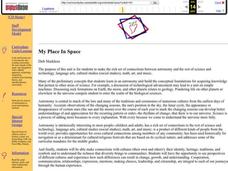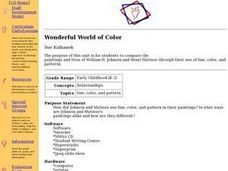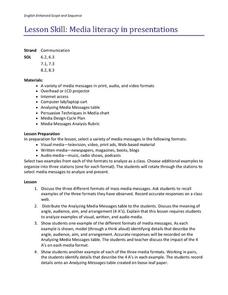Curated OER
Thanks for Your Service
Students thank their freedom fighters. In this Veteran's Day lesson, students honor members of the U.S. Armed Forces by designing a program to pay tribute to them. Students use technology tools to conduct interviews, take pictures, and...
Curated OER
A Walk Through the 20th Century
Students use primary and secondary sources to study the literature, historical events, people, technology, medicine, government, entertainment and culture of the decades of the twentieth century.
Curated OER
Protest Music Video
Students create an iMovie that expresses the meaning of a protest song from the 1960's or 1970's. They investigate the emotional and political overtones of the times and use images to interpret the song's meaning.
Curated OER
Cyberspace
Students create original works of art or music and upload them to the Internet. They work individually or in a group. Then they collaborate with others to interpret, analyze, or alter the work.
Curated OER
My Place In Space
The purpose of this unit is for students to make the rich set of connections between astronomy and the rest of science and technology, language arts, cultural studies (social studies), math, art, and music.
Curated OER
Social Studies: Medieval and Contemporary Class Structures
Students discuss and compare contemporary class systems with those of the Middle Ages. They explore Websites on HyperStudio stack and review art and music of the Middle Ages. In groups, students design and draw castles reflecting manor...
Curated OER
Presentation Culturelle
Students explore various aspects of French life. They determine
which topic dealing with French history, art, food, music, dance, celebrations or traditions they research and present.
Curated OER
Learning Abstract Concepts
Learners create iMovies depicting abstract concepts, such as sorrow, future, wishes, infinity, etc., in this technology-based Visual Arts/Language Arts lesson. Music can be used to enhance created movies.
Curated OER
Web Puts Undiscovered Musicians, Listeners In Tune
Students read an article from USA Today about technology and the music business. In this news article instructional activity, students read an article about failed musicians and their new roles in music and technology. Students discuss...
Curated OER
Copyright, Sampling and Mashing
Students examine copyright laws in regard to sharing, sampling and mashing music. After listening to pieces of music, they create their own music sample by combining musical elements and expression. Students visit a specified website...
Curated OER
Wonderful World of Color
Students compare the paintings and lives of William H. Johnson and Henri Matisse through their use of line, color, and patterns to publish an individual fact book. They then create an imaginary painting while listening to classical music.
Curated OER
We Are Super-Duper!
Learners explore the concept that each person is unique, special and valuable and assess how to express that concept with positive attitudes through role play, music and art. They email a friend or family member a special message with a...
Curated OER
We Are Alike, We Are Different:A Focus on Japan
First graders develop a connection with students in a first grade classroom in Japan. They begin to develop a curiosity about Japan--the landscape, the people, and their culture, while developing an understanding of the Five Themes of...
Curated OER
Teaching the Instruments of the Orchestra to Young Students using the San Francisco Symphony Kids’ Website
Using the San Francisco Children's Orchestra web site, first graders build listening and instrument identification skills. Each child wears head phones, listens to ID, and finds various instruments on the included worksheet.
Curated OER
Literature Through Silent Movies
Students participate in an engaging, alternative assessment activity: making a silent film of an Edgar Allen Poe story. This project offers them an additional way to demonstrate their mastery of the topic.
Curated OER
The Ultimate Instrument!
Third graders identify the four instrument families of the symphony orchestra. They listen to the instruments and compare the similarities and differences of each of the four families. They design and create an instrument that belongs to...
Curated OER
Media Literacy in Presentations
Middle schoolers study the three types of mass media messages: visual media, written media, and audio media. After a class discussion which has them list examples of each, learners get into pairs and work on analyzing the "Four A's" in...
Curated OER
Digital Curation: Life and Times of Mark Twain
By digitally organizing research, your class leaves a legacy for future young scholars on the life and times of Mark Twain. Before reading The Adventures of Tom Sawyer, scholars conduct group research projects on one of six (listed)...
Curated OER
Compose Your Memory
Students notate a short musical composition using the notation software Sibelius. This composition is based on a the student's favorite childhood memory. Based on their emotions felt at this time, they incorporate tempo, range, and...
Curated OER
The Classical Period
Sixth graders are introduced to the classical period in music history. After listening to examples, they identify and describe the characteristics of music during this time period and research the main composers. Using the internet,...
Curated OER
Crosby, Stills, Nash and Young: Exploration of Live vs. Recorded
Students examine the differences between live and recorded music using the music of Crosby, Stills, Nash and Young.
Curated OER
Rock Till You Drop!
Students study rhythmic patterns and phrases on percussion instruments. They form a drum circle and take turns playing the beat. After listening to styles of rhythms, students compare styles of music. They compose a short piece of...
Curated OER
Behind the Movie Chicago
Learners explore the genre of the musical film and its history. They draw conclusions on relationships between a stage musical and a musical film. They share the results of their research as a class.
Curated OER
The Sorcerer's Apprentice
Third graders listen to "The Sorcerer's Apprentice". Using the music, they identify the high and low parts in the orchestal composition. They compare the elements of a story to the piece of music and respond to the music and state how...

























